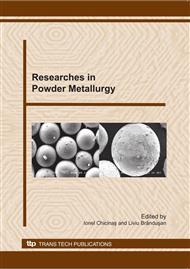p.12
p.17
p.23
p.31
p.39
p.47
p.55
p.59
p.63
Production of Ceramics Reinforced Al Foams by Powder Metallurgy Techniques
Abstract:
Powders metallurgy route was used to produce foams from pure Al powders and pre-alloyed Al alloy powders (Alumix 231) with or without reinforcing elements addition. Both classical Al foam and spherical Al foam were produced with various production parameters and the results obtained have been discussed. SiC particles were used as reinforcing elements and TiH2 powders were used as foaming agent. Prior to compaction process, Al powders, reinforcing element and foaming agent were mixed in a three dimensional turbula for 30 min. Mixed powders were compacted, sintered and deformed and then foamed at 690 oC for spherical foam and 710 oC for classical foam. Effect of volume fraction of reinforcing elements, foaming temperatures and foaming agent amounts on the foaming behavior, pore structure, pore distribution, linear expansion rate, density and wall thickness of the cell were investigated. Experimental studies have shown that 1% foaming agent and 4 % SiC addition was found to be the most suitable for foaming. In general foam produced from Alumix 231 powders exhibited more homogenous pore structure compared to the ones produced from pure Al powders.
Info:
Periodical:
Pages:
39-46
Citation:
Online since:
January 2011
Authors:
Keywords:
Price:
Сopyright:
© 2011 Trans Tech Publications Ltd. All Rights Reserved
Share:
Citation:


